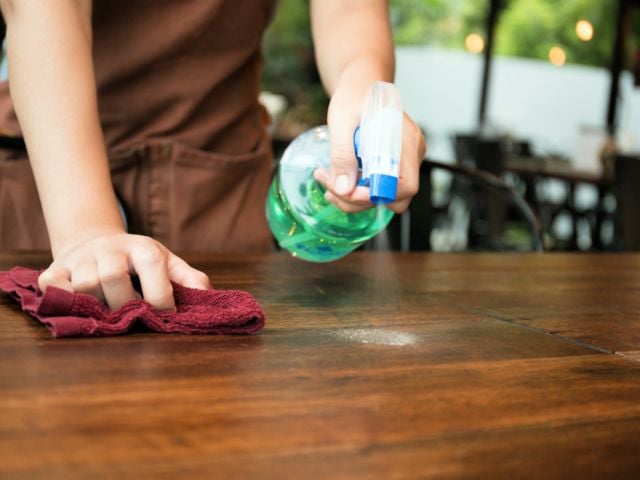WASHINGTON – The tragic death of a restaurant worker who was overcome from fumes after two cleaning agents were accidentally mixed together is a cautionary example of the serious risks to people when certain chemical-containing cleaning products are blended together.
A manager of a Buffalo Wild Wings in Massachusetts died after he inhaled a mix of cleaners that contained acid and bleach. The fumes created after two products, Scale Kleen and Super 8, were unknowingly combined while cleaning a kitchen floor. The mixture quickly turned green, started to bubble and the fumes overpowered the worker as he attempted to squeegee the noxious liquid outside into the drain.
The man, whose name has not yet been released, died shortly after being taken to a nearby hospital. Ten other workers and patrons were sickened as a result of the fumes.
“Our thoughts are with the family, friends and co-workers of this gentleman,” said Samara Geller with EWG. “No one should be put in a situation where simply coming to work and doing their job could result in serious injury or even death from toxic cleaning products. Unfortunately, this is a persistent issue that triggers tens of thousands of illnesses and poisonings each year in the U.S.”
The risks of both acute (near term), and chronic (long term) impacts from improper or accidental mixing of certain cleaning chemicals is a serious threat to workers who spend part or all of their days indoors handling these products. The impacts from not following the label instructions can quickly result in a range of health issues, including eye and airway irritation to even death.
Workers that clean for a living or clean as part of their job duties are disproportionately exposed to hazardous chemicals because they handle these cleaning products more frequently – often constantly throughout the day. As a result, they suffer elevated rates of debilitating injuries and illnesses. Scientific literature and clinical data show a link between exposure to conventional cleaning products and exacerbating or causing costly health conditions requiring medical evaluation and treatment – like chronic skin rashes or asthma.
Bleach-based products used by janitors, domestic workers and others who clean as part of their job duties are especially concerning due to the high risk of the accidental mixture with other acid-based cleaners and ammonia.
For example, when ammonia and chlorine bleach are mixed together, they create toxic chloramine gas. And improper mixing of bleach and acidic cleaners can create chlorine gas, which can trigger an asthma attack after a single high-level exposure.
Tips:
Avoid the respiratory irritants and asthmagens ammonia and sodium hypochlorite:
- They are otherwise known as chlorine bleach.
- A wide range of products contain sodium hypochlorite, not just laundry bleaches. Everything from all-purpose cleaners to bathroom cleaners and dish detergents may contain bleach.
- Ammonia is typically found in all-purpose and glass cleaners. This ingredient can cause or worsen allergic reactions and asthma, and can irritate and burn skin, eyes and lungs.
Cleaning combinations you should especially avoid:
- Never mix ammonia and chlorine bleach together. The combination creates toxic chloramine gas.
- Improper mixing of bleach with acidic cleaners can create chlorine gas which, for example, has the potential to cause asthma after a single, high-level exposure.
Pay attention to alternative names for chemicals:
- Bleach may be listed on the label as sodium hypochlorite. Sometimes a label may just simply state bleaching agent.
- Ammonia may be listed on the label as ammonium hydroxide.
- Studies have shown that long-term exposure in workers in the cleaning industry can cause chronic respiratory health problems, including lung disease.
For those concerned about the chemicals used in commercial and in-home cleaning products, EWG researchers have compiled helpful information to assist workers and consumers to better understand what to be on the lookout for when buying and handling cleaning products.
###
The Environmental Working Group is a non-profit, non-partisan organization that empowers people to live healthier lives in a healthier environment. Through research, advocacy and unique education tools, EWG drives consumer choice and civic action.



